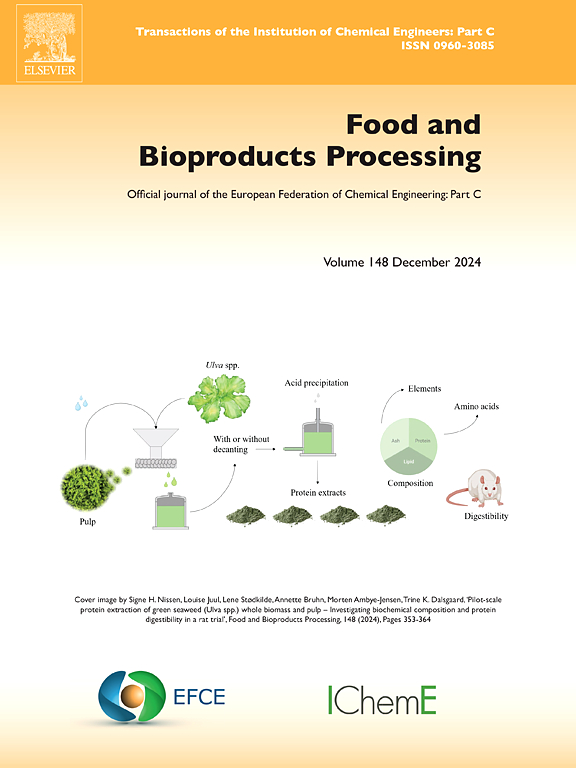Aerogels based on proteins extracted from plant sources: Different production methodologies
IF 3.5
2区 农林科学
Q2 BIOTECHNOLOGY & APPLIED MICROBIOLOGY
引用次数: 0
Abstract
Aerogels based on protein offer an exciting and biodegradable solution for the delivery of proteins and nutrients in food supplements, and they can also be used as carriers for drug delivery. Comparing freeze drying with supercritical drying and five different protein sources (mallow leaves, sugar beet leaves, faba beans, pumpkin seeds, and sunflower seeds), it is observed that aerogels obtained by supercritical drying from mallow leaves and sugar beet leaves show a good homogeneous porosity, higher adsorption capacity (3.48 % after 48 h), and higher surface areas (127.2 and 259 m2/g). Consequently, these aerogels were chosen to conduct the impregnation of α-tocopherol (α-TOC), which was selected as a model drug to explore the feasibility of utilizing this aerogel for drug delivery. The amount of α-TOC loaded through the supercritical impregnation technique is approximately 0.5 mgα-TOC/mgaerogel for both the sugar beet and mallow aerogels. From the dissolution test, both aerogels allow a prolonged release of about 24 hours with respect to the pure α-TOC that occurs in 1 hour. By adjusting the pH value of the starting aqueous solution, the solubility of the protein in water was increased to obtain a homogeneous porosity dispersion.
从植物中提取蛋白质的气凝胶:不同的生产方法
基于蛋白质的气凝胶提供了一种令人兴奋的可生物降解的解决方案,用于在食品补充剂中输送蛋白质和营养物质,它们也可以用作药物输送的载体。将冷冻干燥与超临界干燥以及5种不同蛋白质源(锦葵叶、甜菜叶、蚕豆、南瓜籽和葵花籽)进行比较,发现锦葵叶和甜菜叶经超临界干燥得到的气凝胶具有良好的均匀孔隙度,48 h后的吸附量为3.48 %,比表面积为127.2和259 m2/g。因此,选择这些气凝胶进行α-生育酚(α-TOC)的浸染,并选择α-TOC作为模型药物,探讨利用该气凝胶进行药物递送的可行性。通过超临界浸渍技术,甜菜气凝胶和锦葵气凝胶的α-TOC负载量均约为0.5 mgα-TOC/ megogel。从溶解测试来看,两种气凝胶都允许在1 小时内释放纯α-TOC的时间延长约24 小时。通过调整起始水溶液的pH值,提高蛋白质在水中的溶解度,获得均匀的孔隙度分散。
本文章由计算机程序翻译,如有差异,请以英文原文为准。
求助全文
约1分钟内获得全文
求助全文
来源期刊

Food and Bioproducts Processing
工程技术-工程:化工
CiteScore
9.70
自引率
4.30%
发文量
115
审稿时长
24 days
期刊介绍:
Official Journal of the European Federation of Chemical Engineering:
Part C
FBP aims to be the principal international journal for publication of high quality, original papers in the branches of engineering and science dedicated to the safe processing of biological products. It is the only journal to exploit the synergy between biotechnology, bioprocessing and food engineering.
Papers showing how research results can be used in engineering design, and accounts of experimental or theoretical research work bringing new perspectives to established principles, highlighting unsolved problems or indicating directions for future research, are particularly welcome. Contributions that deal with new developments in equipment or processes and that can be given quantitative expression are encouraged. The journal is especially interested in papers that extend the boundaries of food and bioproducts processing.
The journal has a strong emphasis on the interface between engineering and food or bioproducts. Papers that are not likely to be published are those:
• Primarily concerned with food formulation
• That use experimental design techniques to obtain response surfaces but gain little insight from them
• That are empirical and ignore established mechanistic models, e.g., empirical drying curves
• That are primarily concerned about sensory evaluation and colour
• Concern the extraction, encapsulation and/or antioxidant activity of a specific biological material without providing insight that could be applied to a similar but different material,
• Containing only chemical analyses of biological materials.
 求助内容:
求助内容: 应助结果提醒方式:
应助结果提醒方式:


